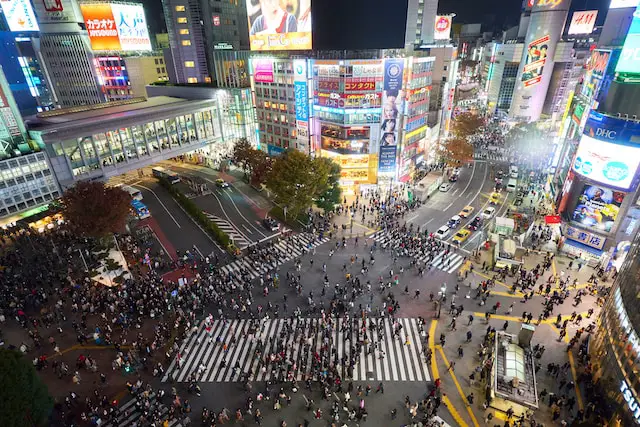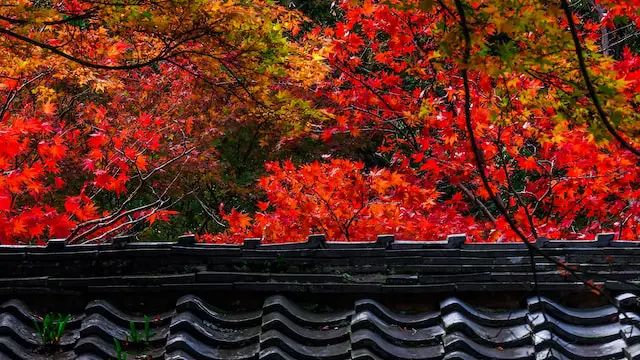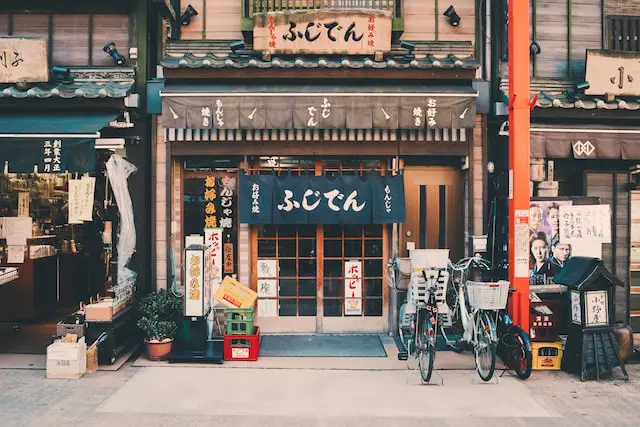Bridges in Japan have a rich history and hold significant cultural value, gracefully combining aesthetics with function. From ancient times, these architectural marvels served as important links, each uniquely embodying the era they were built in, from the sophistication of the Heian period, through the edo period, to the zenith of modern engineering we see today.
Don’t miss exploring them as part of your Japanese journey. Each bridge has its own story or legends attached, adding to the mystique of the landscape. In fact, a handful of these bridges are part of the country’s national treasures and important cultural properties, underscoring their importance in the country’s rich tapestry. As a traveller, visiting these bridges will give you an unparalleled insight into Japan’s history, culture, and ingenious architecture. So, are you ready to discover some of Japan’s most iconic bridges?
The Akashi Kaikyō Bridge: The World’s Longest Suspension Bridge
Any journey through Japan would be incomplete without witnessing the stunning spectacle that is the Akashi Kaikyō Bridge. Not only a striking silhouette against the azure backdrop of the Kobe Strait, but this bridge also claims the prestigious title of the world’s longest central span of any suspension bridge.
Boasting an impressive length of 1991 meters, this engineering marvel stands as a testament to Japan’s revolutionary engineering prowess. It effortlessly bridges the gap between the city of Kobe on the mainland and Awaji Island, and offers commuters a breathtaking view of the strait below.
The Akashi Kaikyō Bridge, affectionately referred to as the Pearl Bridge, is a marvel of modern design innovatively mixed with traditional aesthetics. It offers the viewer an opportunity to marvel at its grandeur while also inviting them to ponder about the technological know-how required to bring such a project to fruition.
A trip across the bridge is, without question, a captivating experience that offers panoramic views of the Kobe skyline and the tranquil waters of the Inland Sea. Whether you’re a fan of revolutionary engineering, a lover of landscapes, or an admirer of incredible structures, the Akashi Kaikyō Bridge is a sightseeing staple you can’t afford to miss on your Japanese journey. It doesn’t just bridge lands, it bridges the gap between awe-inspiring nature and human ingenuity.
Indeed, it is not just a bridge, but a symbol of Japan’s indomitable spirit and perseverance.
Kintai Bridge: The Historic Five-arched Wooden Bridge of Iwakuni
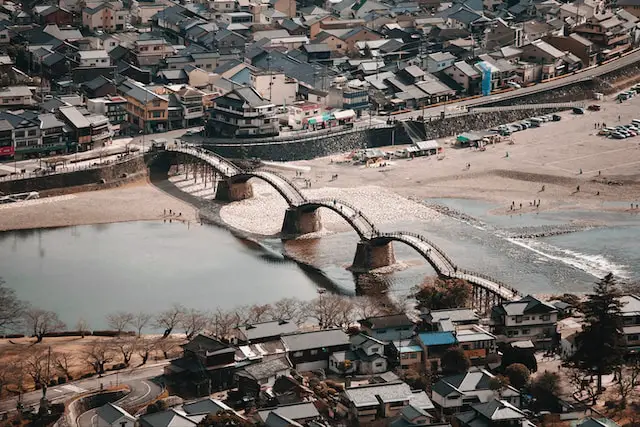
The Japanese archipelago is replete with grand and intricate landmarks, but none quite encapsulate the harmonious fusion of architectural prowess and aesthetic elegance like the Kintai Bridge. Fondly considered one of the most iconic structures in Japan, this dramatic five-arched wooden bridge graces the city of Iwakuni in Yamaguchi Prefecture.
Constructed in 1673 during the Edo period, the Kintai Bridge is a testament to the brilliance of Japanese traditional construction. The bridge’s structure resembles that of a mountainous landscape, its magnificent wooden arches rising and descending over the serene Nishiki River. It is an architectural marvel that captures the aesthetic essence and ingenious craftsmanship of a bygone era.
The Kintai Bridge, however, is not just about its physical allure. It is also steeped in history. Tragically destroyed by floods several times, it was always faithfully reconstructed, testifying to the resilience and tenacity of the Japanese people. The current bridge, built without the use of nails, is the result of meticulous efforts to recreate the structure as close as possible to the original.
Visiting the bridge provides a step back in time. As you stroll across its sturdy wooden pathways, envision the countless generations that also marvelled at its harmonious blend of nature, artistry, and architecture. An integrated part of Iwakuni’s culture and history, the Kintai Bridge is a must-visit for travellers seeking to experience the heart of Japan.
So, next time you are planning your Japan travels, extending your exploration beyond conventional tourist spots to the Kintai Bridge promises to be an enlightening and enriching experience.
Rainbow Bridge: An Iconic Landmark of Tokyo
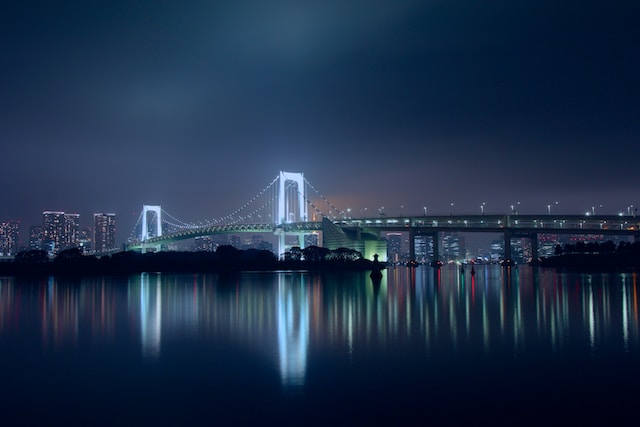
When speaking of Tokyo sightseeing, one cannot miss mentioning the iconic Rainbow Bridge. An embodiment of Tokyo’s modern charm and dynamism, this magnificent suspension bridge, spanning Tokyo Bay, is both a crucial transport link and a visual wonder.
Standing proud at 798 meters long with a vibrant spectrum of colors lighting up the night sky, the Rainbow Bridge aptly reflects its namesake. Unlike its daytime façade, the bridge casts a beautiful glow, incessantly changing colors from dusk till dawn. Its silhouette against Tokyo’s dazzling metropolis is a sight that underscores the city’s unending allure.
Conceiving an opportunity to view Tokyo from a new vantage point, one can effortlessly find the bridge’s pedestrian walkway. This walkway presents an unrivaled panorama of Tokyo Tower, Tokyo Skytree, and even the Odaiba district — a masterstroke for photographers and travel enthusiasts alike.
The illumination of the Rainbow Bridge is not only a magnificent display but holds a deeper, symbolic meaning. The energy-saving solar illumination displays a white radiance during summers and a seasonal rainbow spectrum during the winter months, tying in harmoniously with Japan’s deep-rooted cultural tradition of celebrating the seasons.
In conclusion, the mesmerizing spectacle of the Rainbow Bridge truly signifies its status as a must-visit landmark in Tokyo. The bridge serves as an architectural testament to Tokyo’s remarkable urban evolution and the balance it strikes between modernity and tradition.
Embrace the sparkling city lights and delightful views from this iconic Tokyo marvel, and the Rainbow Bridge will unquestionably color your travel experiences in Japan.
The Spectacular Megane-bashi: Japan’s Oldest Stone Arch Bridge
As you traverse the historical city of Nagasaki, be ready to witness the splendid charm of Megane-bashi, Japan’s oldest stone arch bridge. Named after its spectacle-like reflection in the water, Megane-bashi (Glasses Bridge) enriches the canvas of Nagasaki tourism with its timeless elegance and intriguing history.
Constructed in 1634, this stone bridge survived the test of time and is a testament to the resilience of Japan’s time-honored construction methods. Its arches, gracefully standing over the Nakashima River, have been a beloved subject of photographers and history buffs alike.
Megane-bashi stands out not just for its age but for its unique design. The low, parallel arches reflect perfectly in the river below, creating a visual effect that gives the bridge its name. This dramatic view is particularly captivating during the cherry blossom season, making it a favorite among locals and tourists.
Playing an essential role in Nagasaki’s cultural landscape, Megane-bashi’s importance extends beyond its historical and aesthetic charms. This bridge has been restored several times, particularly after the devastating floods of 1982. Every restoration effort manifests the community’s commitment to preserving their ancestral heritage.
Visiting the Megane-bashi bridge is like stepping back in time, a journey into Japan’s past that embodies the juxtaposition of history and modernity that characterizes this beautiful country. Along with exploring the extraordinary landmarks of Nagasaki, make sure Megane-bashi is on your must-see list.
To conclude, amidst the array of modern structures, Megane-bashi stands as a symbol of Japan’s enduring aesthetic and traditional values, establishing itself as an essential part of Nagasaki tourism.
Bandai Bridge: An Integral Part of Niigata’s Skyline
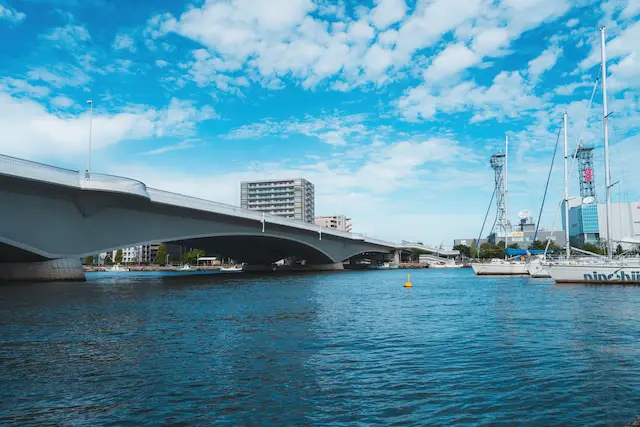
Reaching across the glittering expanses of the Shinano River, the Bandai Bridge stands as a distinguished public architecture that’s integral to the picturesque Niigata cityscape. Opened in 1886 and designated an Important Cultural Property of Japan, Bandai Bridge isn’t just a crucial transportation route, but a cultural touchstone that offers a profound view of the past and the unfolding present.
In a city often invigorated by commerce and known for its thriving port, Bandai Bridge forms an essential artery that channels the city’s heartbeat. Despite its age, the bridge is far from being old-fashioned. It was revamped in 1929 with a modern, concrete structure that blends seamlessly into the landscape, whilst maintaining a touch of traditional aesthetic charm.
Today, Bandai Bridge isn’t just a passageway, but a destination. When twilight descends on Niigata, the bridge illuminates, casting a magical glow over the river. Measuring at 306.9m long and 22.2m wide, it becomes a stage for locals and tourists alike to gaze at the spellbinding reflections dancing on the river’s surface, a moment to appreciate the harmonious fusion of urban life and natural scenery.
Whether it’s a peaceful daytime walk or an enchanting evening stroll, Bandai Bridge offers experiences and views that are compelling and scenic. It’s a testament to Japanese craftsmanship and their dedication to creating structures that not only serve practical functions but also capture the soul and spirit of the city. As part of your Japan travel itinerary, do immerse yourself in Niigata’s vibrant culture and history by paying a visit to this captivating iconic Japanese architecture.
Seto Ohashi Bridge: The World’s Longest Two-tiered Bridge System
Journeying onto the Seto Ohashi Bridge, it’s impossible to be anything less than captivated. Spanning the serene Seto Inland Sea, this architectural marvel is the world’s longest two-tiered bridge system,
Boasting an impressive total length just over 13.1 kilometers, this combined road-rail bridge system connects Japan’s main Honshu Island to Shikoku Island. It’s an embodiment of Japan engineering marvels, merging technical prowess with a seemingly effortless grace in design.
While being a pivotal transit route, the Seto Ohashi Bridge is much more than just a functional conduit; it serves as a lofty vantage point, offering breathtaking panoramic views over the sapphire waters of the Seto Inland Sea. These picturesque seascapes that unfold from the bridge have gained a reputation as one of Japan’s most incredible sights. Whether experienced from a speeding train or leisurely drive, the view is equally magnificent.
Each year, thousands of visitors flock to take that mesmeric journey over the bridge, marveling at the beauty of the natural surroundings synergizing with this phenomenal structure. The Seto Ohashi Bridge, in essence, is a testament to Japan’s architectural excellence, adorning the Inland Sea like a serene, colossal dragon.
As part of your Japan travel itinerary, a drive on the Seto Ohashi Bridge offers a unique experience, a chance to witness this ‘pearl’ of Japanese engineering brilliance.
Shin Yamaguchi Ohashi: Showcasing Contemporary Japanese Architecture
Japan is renowned for its wonderful amalgamation of traditional and contemporary architectural marvels, perfectly displayed in its bridges. The Shin Yamaguchi Ohashi is an embodiment of this blend, being an exhibit of modern Japanese design and technical ingenuity.
This truss bridge in Yamaguchi Prefecture is an engineering marvel that has earned its place among the noteworthy wonders of Japan. Its strikingly modern and sleek design contrasts beautifully with the serene, natural beauty of the surrounding landscape.
Constructed in the 21st century, the magnificent Shin Yamaguchi Ohashi is an emblem of avant-garde Japanese bridge construction. Its grandeur and cutting-edge design serve as a testament to the progressive ethos of Japan, making it an important touchstone of contemporary Japanese architecture. Constructed over the pristine waters of the Yoshida River, the bridge adds to the tranquil charm of the cityscape.
From a distance, the bridge’s intricate pattern creates a stunning visual reminiscent of a fine lacework, perfectly encapsulating the architectural precision that Japanese builders are renowned for. During the evening hours, the bridge’s intelligent illumination design creates a mesmerizing spectacle that’s not to be missed.
On your visit to the Land of the Rising Sun, the Shin Yamaguchi Ohashi is a sight you mustn’t overlook. Not just for the fantastic view it offers, but also to witness and admire the epitome of Contemporary Japanese Architecture that it showcases. This intricate marvel truly celebrates the nation’s innovative spirit and dedication to design precision.
Chikugo River Lift Bridge: The Last of its Kind in Japan
Take a moment to imagine bridges reminiscent of a bygone era, lifting their spans to allow boats to pass underneath. This is precisely the fascinating spectacle that the Chikugo River Lift Bridge offers. As the sole operational lift bridge in Japan, this historical marvel commands a peak position among Fukuoka attractions.
The Chikugo River Lift Bridge, originally completed in 1935, was an ingenious creation to combat the challenges posed by the frequent ship traffic on the Chikugo River. With a lifting mechanism that can raise the central span 23 meters above the water, it was, and still is, a masterstroke in bridge engineering.
Today, while no longer serving its original function due to the completion of a bypass tunnel in 1987, the bridge has been transformed into an open-air museum. As you stroll through its weathered structures, you will find the rich history of Japan folded into its steelwork. One can’t help but marvel at the technical prowess displayed in this early 20th-century infrastructure.
Visiting the Chikugo River Lift Bridge offers more than just a glimpse of Japanese engineering legacy; it’s a step back into a slice of history. Whether you’re an architecture enthusiast or simply someone seeking a unique history-filled excursion, this should absolutely make your list of must-see places when visiting Fukuoka.
In essence, visiting the Chikugo River Lift Bridge offers an extraordinary chance to view vestiges of Japan’s past that continue to stand tall amidst modern advancements. Don’t miss this chance to capture the spectacle of the rising spans of the last operational lift bridge in Japan!
Conclusion
In conclusion, a journey through Japan would be incomplete without including its iconic bridges known not just for their utility, but also for their grandeur and aesthetic charm. Playing pivotal roles in both the history and everyday life of the Japanese people, these bridges bear witness to the country’s architectural prowess and cultural significance.
From the world’s longest suspension bridge, the Akashi Kaikyō Bridge, to the last operational lift bridge at Chikugo River, the spectrum of Japanese bridges invite visitors to appreciate the genius behind their construction. As portals between cityscapes, they also offer unrivalled opportunities for sightseeing and immersion in the local culture.
It’s heartily recommended for every traveler to make these bridges part of their Japan travel itinerary. After all, they truly embody the spirit of resilience, artistry, and innovation that define this remarkable nation. Explore, marvel, and appreciate – the bridges of Japan are waiting for you.

